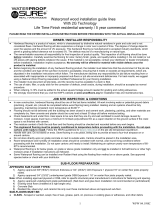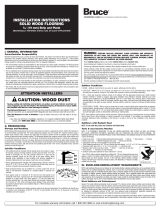Page is loading ...

READ THESE INSTRUCTIONS TOROUGHLY BEFORE INSTALLING
Products are made with real wood presenting various designs and shades for a beautifully rich finish. Each plank is unique
to give the decor a warm and natural look.
Wood Pine Planks can be installed on any structurally sound, clean, dry and flat surface.
Wood Pine Planks are NOT to be installed as flooring. The product must be used on interior walls only.
Apply a minimum of one coat of primer sealer to cement block, plaster and gypsum surfaces prior to installation.
Self adhesive wood wall planks are not recommended to be used in areas where the temperature can exceed 122° F (e.g.
near a fireplace) nor in rooms that can become damp (e.g. a bathroom, shower room).
Wood Pine Planks must be installed in areas where the humidity level remains between 40% and 60%.
The wood should rest flatly in its box at room temperature for at least 72 hours before installation.
To ensure a consistent and natural result, mix the content from all the boxes prior to beginning installation
American Pro Decor assumes no liability for improper installation 1 / 2

PREPARATION
Installation steps may vary according to the desired look. Systematically plan the layout, design, and the amount of
wood necessary to complete the wall before beginning installation.
Self-adhesive wood wall planks adhere to several surfaces such as plasterboard (unpainted, primed or painted),
concrete, plywood, or plaster walls. Ensure that the surface to be covered is clean, dry, and smooth. Unevern areas
must be adjusted. Clean the wall with a dry cloth, but do not use any cleaning products as they may affect the effectiveness
of the adhesive strips.
If the wall is freshly painted, wait until it is completely dry. We recommended a 72-hour waiting period.
All electrical outlets and switch plates should be removed.
INSTALLATION
Start the installation at the top of the wall. Try not to follow the ceiling line, as it may not be leveled.
To ensure that the first row of wood is absolutely straight, place a board at the top of the wall using a level and mark
a reference line below the piece. Trace a line with the level from one end of the wall to the other starting from this
reference point.
Remove the protective film from the adhesive strips on the back of the first plank and place it following your reference
line. Stick the top of the board first, then the bottom, and press firmly for 10 seconds.
Repeat for each plank along the row.
If necessary, cut the boards with a hand saw or circular saw, taking care to properly measure so that they will fit
perfectly to the adjacent pieces. Before removing the adhesive strips, test each board in place. Once adhered, the
board cannot be moved.
We recommend installing the board from left to right, and using the left over trim from the last piece of a row to start
the next row.
For a natural finish, take care not to layer the joints from one row to the next so that they don’t form a vertical line. We
recommend offsetting the joints by at least six inches between rows (see examples below).
Once all the boards are installed, apply pressure using a rubber (J) Roller
PROPOSITION 65 WARNING: Drilling, sawing, sanding or machining wood products generates wood dust, a substance known to the
State of California to cause cancer. Use a respirator or other safeguards to avoid inhaling wood dus
American Pro Decor assumes no liability for improper installation 2 / 2
/



